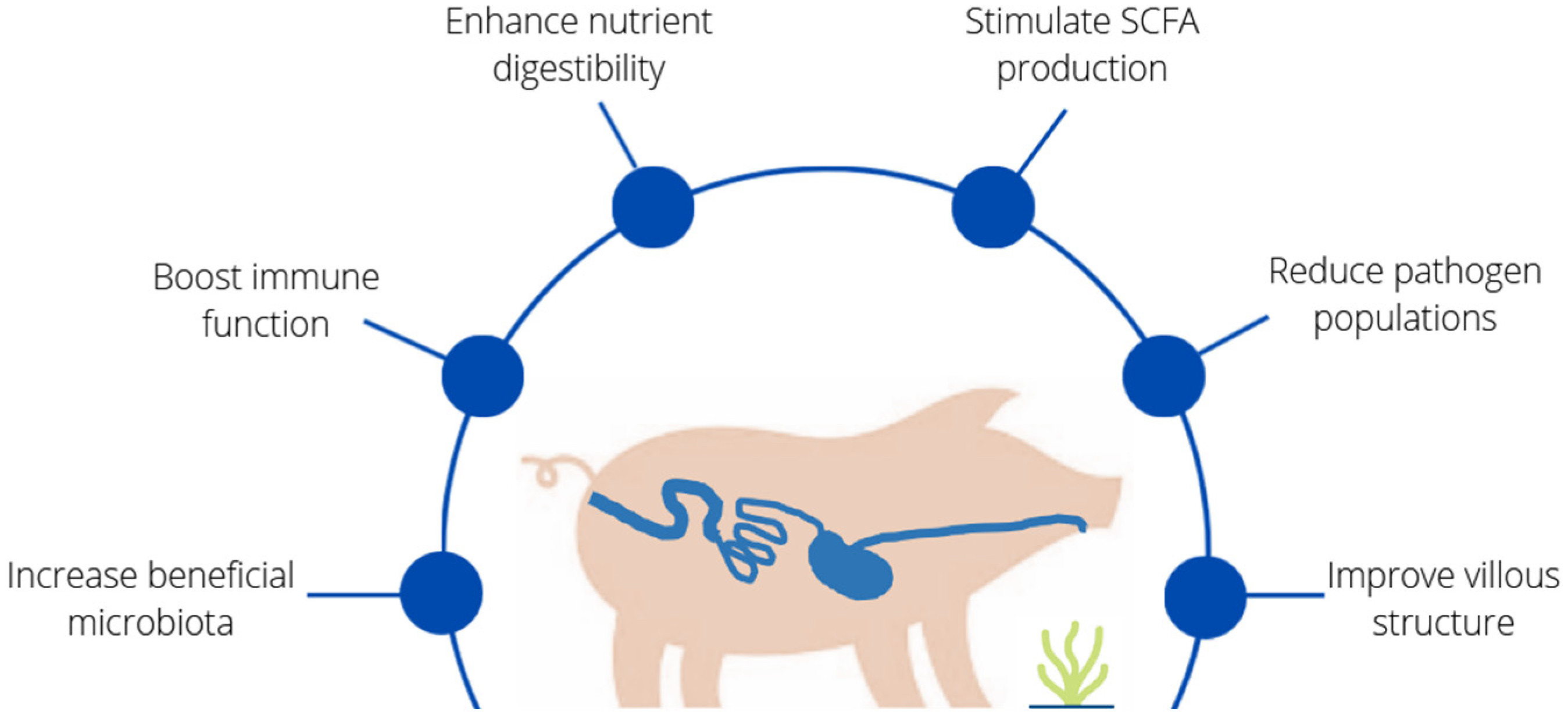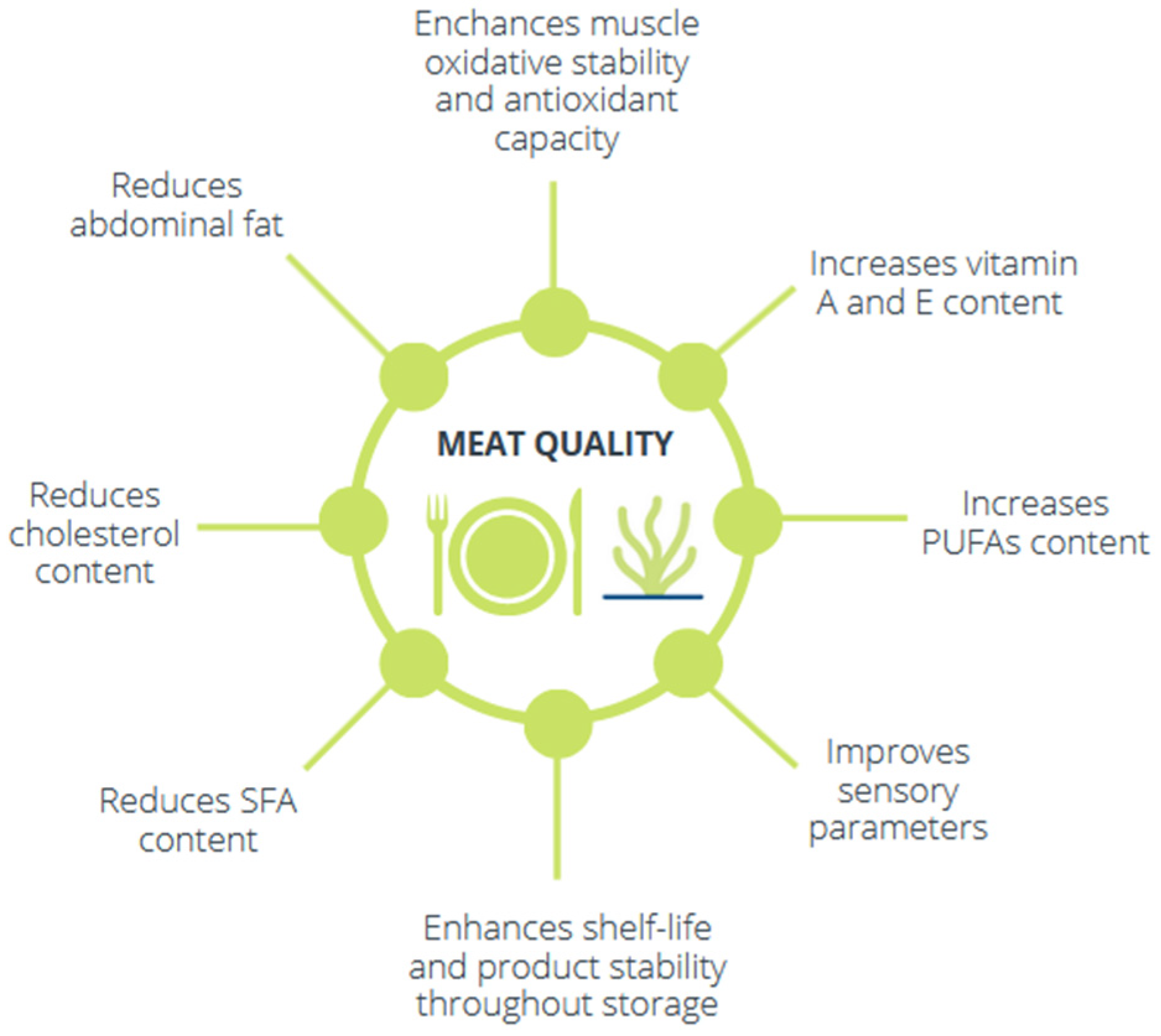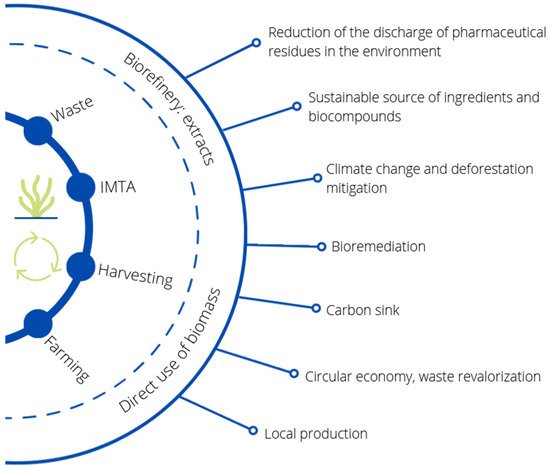
| Version | Summary | Created by | Modification | Content Size | Created at | Operation |
|---|---|---|---|---|---|---|
| 1 | Sabela Al-Soufi Novo | -- | 2610 | 2022-09-14 12:15:05 | | | |
| 2 | Peter Tang | Meta information modification | 2610 | 2022-09-15 03:03:08 | | |
Video Upload Options
The inclusion of algae in animal feed has experimentally proven to help to reduce intestinal dysbiosis. However, further studies evaluating the prebiotic effects of algal components on gut health and also identifying the compounds directly responsible for the antimicrobial, antiviral, antioxidative and anti-inflammatory properties of algae are still needed. Furthermore, the inclusion of marine algae in rabbit food could potentially become a commercial marketing strategy that could attract new consumers who are concerned about environmental sustainability and who are looking for different, high-quality foods.
1. Introduction
2. Seaweed and Gut Health
|
Polysaccharide |
Chemical Structure |
Biological Properties |
|---|---|---|
|
Ulvan |
L-rhamnose, D-xylose, D-glucose and D-glucuronic acid. |
Antioxidant, anticoagulant, anti-inflammatory, immune-stimulatory, antibacterial, antihyperlipidemic. |
|
Fucoidan |
1,3-α-fucopyranoside backbone with branching of α-1,2-fucopyranoside |
Antioxidant, anticoagulant, anti-inflammatory, antiviral, immune-modulatory. |
|
Laminarin |
1,3-β-D-glucan with β-1,6-linkages. |
Antioxidant, anticoagulant, anti-inflammatory, antiviral, immune-modulatory, prebiotic. |
|
Alginate |
1,4-β-D-mannuronic acid and α-L-guluronic acid residues. |
Antioxidant, anti-inflammatory, antitumor. |

3. Seaweed and Meat Quality

4. Seaweed and Sustainable Animal Farming

References
- Petracci, M.; Soglia, F.; Leroy, F. Rabbit Meat in Need of a Hat-Trick: From Tradition to Innovation (and Back). Meat Sci. 2018, 146, 93–100.
- Cullere, M.; Dalle Zotte, A. Rabbit Meat Production and Consumption: State of Knowledge and Future Perspectives. Meat Sci. 2018, 143, 137–146.
- Trocino, A.; Cotozzolo, E.; Zomeño, C.; Petracci, M.; Xiccato, G.; Castellini, C. Rabbit Production and Science: The World and Italian Scenarios from 1998 to 2018. Ital. J. Anim. Sci. 2019, 18, 1361–1371.
- Makkar, H.P.S.; Tran, G.; Heuzé, V.; Giger-Reverdin, S.; Lessire, M.; Lebas, F.; Ankers, P. Seaweeds for Livestock Diets: A Review. Anim. Feed Sci. Technol. 2016, 212, 1–17.
- Øverland, M.; Mydland, L.T.; Skrede, A. Marine Macroalgae as Sources of Protein and Bioactive Compounds in Feed for Monogastric Animals. J. Sci. Food Agric. 2019, 99, 13–24.
- Pardilhó, S.; Cotas, J.; Pereira, L.; Oliveira, M.B.; Dias, J.M. Marine Macroalgae in a Circular Economy Context: A Comprehensive Analysis Focused on Residual Biomass. Biotechnol. Adv. 2022, 60, 107987.
- Corino, C.; Modina, S.C.; Di Giancamillo, A.; Chiapparini, S.; Rossi, R. Seaweeds in Pig Nutrition. Animals 2019, 9, 1126.
- Patel, S.; Goyal, A. The Current Trends and Future Perspectives of Prebiotics Research: A Review. 3 Biotech 2012, 2, 115–125.
- Sweeney, T.; O’Doherty, J.V. Marine Macroalgal Extracts to Maintain Gut Homeostasis in the Weaning Piglet. Domest. Anim. Endocrinol. 2016, 56, S84–S89.
- O’Sullivan, L.; Murphy, B.; McLoughlin, P.; Duggan, P.; Lawlor, P.G.; Hughes, H.; Gardiner, G.E. Prebiotics from Marine Macroalgae for Human and Animal Health Applications. Mar. Drugs 2010, 8, 2038–2064.
- De Jesus Raposo, M.F.; De Morais, A.M.M.B.; De Morais, R.M.S.C. Emergent Sources of Prebiotics: Seaweeds and Microalgae. Mar. Drugs 2016, 14, 27.
- Cherry, P.; Yadav, S.; Strain, C.R.; Allsopp, P.J.; Mcsorley, E.M.; Ross, R.P.; Stanton, C. Prebiotics from Seaweeds: An Ocean of Opportunity? Mar. Drugs 2019, 17, 327.
- Morais, T.; Inácio, A.; Coutinho, T.; Ministro, M.; Cotas, J.; Pereira, L.; Bahcevandziev, K. Seaweed Potential in the Animal Feed: A Review. J. Mar. Sci. Eng. 2020, 8, 559.
- Maghin, F. Biological Functions and Health Promoting Effects of Brown Seaweeds in Swine Nutrition. J. Dairy Vet. Anim. Res. 2014, 1, 2–5.
- Hamed, I.; Özogul, F.; Özogul, Y.; Regenstein, J.M. Marine Bioactive Compounds and Their Health Benefits: A Review. Compr. Rev. Food Sci. Food Saf. 2015, 14, 446–465.
- Abu Hafsa, S.H.; Khalel, M.S.; El-Gindy, Y.M.; Hassan, A.A. Nutritional Potential of Marine and Freshwater Algae as Dietary Supplements for Growing Rabbits. Ital. J. Anim. Sci. 2021, 20, 784–793.
- Wells, M.L.; Potin, P.; Craigie, J.S.; Raven, J.A.; Merchant, S.S.; Helliwell, K.E.; Smith, A.G.; Camire, M.E.; Brawley, S.H. Algae as Nutritional and Functional Food Sources: Revisiting Our Understanding. J. Appl. Phycol. 2017, 29, 949–982.
- Pereira, L. Biological and Therapeutic Properties of the Seaweed Polysaccharides. Int. Biol. Rev. 2018, 2, 1–50.
- Salehi, B.; Sharifi-rad, J.; Seca, A.M.L.; Pinto, D.C.G.A. Current Trends on Seaweeds: Looking at Chemical Composition, Phytopharmacology, and Cosmetic Applications. Molecules 2019, 24, 4182.
- de Borba Gurpilhares, D.; Cinelli, L.P.; Simas, N.K.; Pessoa, A.; Sette, L.D. Marine Prebiotics: Polysaccharides and Oligosaccharides Obtained by Using Microbial Enzymes. Food Chem. 2019, 280, 175–186.
- Lopez-Santamarina, A.; Miranda, J.M.; Del Carmen Mondragon, A.; Lamas, A.; Cardelle-Cobas, A.; Franco, C.M.; Cepeda, A. Potential Use of Marine Seaweeds as Prebiotics: A Review. Molecules 2020, 25, 1004.
- Evans, F.D.; Critchley, A.T. Seaweeds for Animal Production Use. J. Appl. Phycol. 2014, 26, 891–899.
- El-banna, S.G.; Hassan, A.A.; Okab, A.B.; Koriem, A.A.; Ayoub, M.A. Effect of Feeding Diets Supplemented with Seaweed on Growth Performance and Some Blood Hematological and Biochemical Characteristics of Male Baladi Rabbits. In Proceedings of the 4th International Conference on Rabbit Production in Hot Climate, Sharm Elsheikh, Egypt, 24–27 February 2005; Volume 382, pp. 373–382.
- Euler, A.C.C.; Ferreira, W.M.; De Teixeira, E.; Lana, Â.M.Q.; Guedes, R.M.C.; Avelar, A.C. Desempenho, Digestibilidade e Morfometria Da Vilosidade Ileal de Coelhos Alimentados Com Níveis de Inclusão de “Lithothamnium”. Rev. Bras. Saúde Prod. An. 2010, 11, 91–103.
- Vizzarri, F.; Chiapparini, S.; Corino, C.; Casamassima, D.; Palazzo, M.; Parkanyi, V.; Ondruska, L.; Rossi, R. Dietary Supplementation with Natural Extracts Mixture: Effects on Reproductive Performances, Blood Biochemical and Antioxidant Parameters in Rabbit Does. Ann. Anim. Sci. 2020, 20, 565–578.
- Vizzarri, F.; Massányi, M.; Knížatová, N.; Corino, C.; Rossi, R.; Ondruška, Ľ.; Tirpák, F.; Halo, M.; Massányi, P. Effects of Dietary Plant Polyphenols and Seaweed Extract Mixture on Male-Rabbit Semen: Quality Traits and Antioxidant Markers. Saudi J. Biol. Sci. 2021, 28, 1017–1025.
- Rossi, R.; Vizzarri, F.; Chiapparini, S.; Ratti, S.; Casamassima, D.; Palazzo, M.; Corino, C. Effects of Dietary Levels of Brown Seaweeds and Plant Polyphenols on Growth and Meat Quality Parameters in Growing Rabbit. Meat Sci. 2020, 161, 107987.
- Rossi, R.; Vizzarri, F.; Ratti, S.; Palazzo, M.; Casamassima, D.; Corino, C. Effects of Long-Term Supplementation with Brown Seaweeds and Polyphenols in Rabbit on Meat Quality Parameters. Animals 2020, 10, 2443.
- López-Gálvez, G.; López-Alonso, M.; Pechova, A.; Mayo, B.; Dierick, N.; Gropp, J. Alternatives to Antibiotics and Trace Elements (Copper and Zinc) to Improve Gut Health and Zootechnical Parameters in Piglets: A Review. Anim. Feed Sci. Technol. 2021, 271, 114727.
- Trevisi, P.; Luise, D.; Correa, F.; Messori, S.; Mazzoni, M.; Lallès, J.P.; Bosi, P. Maternal Antibiotic Treatment Affects Offspring Gastric Sensing for Umami Taste and Ghrelin Regulation in the Pig. J. Anim. Sci. Biotechnol. 2021, 12, 31.
- Reilly, P.; O’Doherty, J.V.; Pierce, K.M.; Callan, J.J.; O’Sullivan, J.T.; Sweeney, T. The Effects of Seaweed Extract Inclusion on Gut Morphology, Selected Intestinal Microbiota, Nutrient Digestibility, Volatile Fatty Acid Concentrations and the Immune Status of the Weaned Pig. Animal 2008, 2, 1465–1473.
- Dierick, N.; Ovyn, A.; De Smet, S. Effect of Feeding Intact Brown Seaweed Ascophyllum Nodosum on Some Digestive Parameters and on Iodine Content in Edible Tissues in Pigs. J. Sci. Food Agric. 2009, 89, 584–594.
- McDonnell, P.; Figat, S.; Odoherty, J.V. The Effect of Dietary Laminarin and Fucoidan in the Diet of the Weanling Piglet on Performance, Selected Faecal Microbial Populations and Volatile Fatty Acid Concentrations. Animal 2010, 4, 579–585.
- O’Doherty, J.V.; McDonnell, P.; Figat, S. The Effect of Dietary Laminarin and Fucoidan in the Diet of the Weanling Piglet on Performance and Selected Faecal Microbial Populations. Livest. Sci. 2010, 134, 208–210.
- Leonard, S.G.; Sweeney, T.; Bahar, B.; Lynch, B.P.; O’Doherty, J.V. Effects of Dietary Seaweed Extract Supplementation in Sows and Post-Weaned Pigs on Performance, Intestinal Morphology, Intestinal Microflora and Immune Status. Br. J. Nutr. 2011, 106, 688–699.
- McAlpine, P.; O’Shea, C.J.; Varley, P.F.; Flynn, B.; O’Doherty, J.V. The Effect of Seaweed Extract as an Alternative to Zinc Oxide Diets on Growth Performance, Nutrient Digestibility, and Fecal Score of Weaned Piglets. J. Anim. Sci. 2012, 90, 224–226.
- Walsh, A.M.; Sweeney, T.; O’Shea, C.J.; Doyle, D.N.; O’Doherty, J.V. Effect of Supplementing Varying Inclusion Levels of Laminarin and Fucoidan on Growth Performance, Digestibility of Diet Components, Selected Faecal Microbial Populations and Volatile Fatty Acid Concentrations in Weaned Pigs. Anim. Feed Sci. Technol. 2013, 183, 151–159.
- Walsh, A.M.; Sweeney, T.; O’Shea, C.J.; Doyle, D.N.; O’Doherty, J.V. Effect of Dietary Laminarin and Fucoidan on Selected Microbiota, Intestinal Morphology and Immune Status of the Newly Weaned Pig. Br. J. Nutr. 2013, 110, 1630–1638.
- Heim, G.; Walsh, A.M.; Sweeney, T.; Doyle, D.N.; O’Shea, C.J.; Ryan, M.T.; O’Doherty, J.V. Effect of Seaweed-Derived Laminarin and Fucoidan and Zinc Oxide on Gut Morphology, Nutrient Transporters, Nutrient Digestibility, Growth Performance and Selected Microbial Populations in Weaned Pigs. Br. J. Nutr. 2014, 111, 1577–1585.
- O’Shea, C.J.; McAlpine, P.; Sweeney, T.; Varley, P.F.; O’Doherty, J.V. Effect of the Interaction of Seaweed Extracts Containing Laminarin and Fucoidan with Zinc Oxide on the Growth Performance, Digestibility and Faecal Characteristics of Growing Piglets. Br. J. Nutr. 2014, 111, 798–807.
- Choi, Y.; Hosseindoust, A.; Goel, A.; Lee, S.; Jha, P.K.; Kwon, I.K.; Chae, B.J. Effects of Ecklonia Cava as Fucoidan-Rich Algae on Growth Performance, Nutrient Digestibility, Intestinal Morphology and Caecal Microflora in Weanling Pigs. Asian-Australasian J. Anim. Sci. 2017, 30, 64–70.
- Ruiz, Á.R.; Gadicke, P.; Andrades, S.M.; Cubillos, R. Supplementing Nursery Pig Feed with Seaweed Extracts Increases Final Body Weight of Pigs. Austral J. Vet. Sci. 2018, 50, 83–87.
- Wan, J.; Zhang, J.; Chen, D.; Yu, B.; He, J. Effects of Alginate Oligosaccharide on the Growth Performance, Antioxidant Capacity and Intestinal Digestion-Absorption Function in Weaned Pigs. Anim. Feed Sci. Technol. 2017, 234, 118–127.
- Sardari, R.R.R.; Nordberg Karlsson, E. Marine Poly- and Oligosaccharides as Prebiotics. J. Agric. Food Chem. 2018, 66, 11544–11549.
- Dalle Zotte, A.; Szendro, Z. The Role of Rabbit Meat as Functional Food. Meat Sci. 2011, 88, 319–331.
- Cesari, V.; Zucali, M.; Bava, L.; Gislon, G.; Tamburini, A.; Toschi, I. Environmental Impact of Rabbit Meat: The Effect of Production Efficiency. Meat Sci. 2018, 145, 447–454.
- Dalle Zotte, A. Perception of Rabbit Meat Quality and Major Factors Influencing the Rabbit Carcass and Meat Quality. Livest. Prod. Sci. 2002, 75, 11–32.
- Costa, M.; Cardoso, C.; Afonso, C.; Bandarra, N.M.; Prates, J.A.M. Current Knowledge and Future Perspectives of the Use of Seaweeds for Livestock Production and Meat Quality: A Systematic Review. J. Anim. Physiol. Anim. Nutr. 2021, 105, 1075–1102.
- Ribeiro, D.M.; Martins, C.F.; Costa, M.; Coelho, D.; Pestana, J.; Alfaia, C.; Lordelo, M.; de Almeida, A.M.; Freire, J.P.B.; Prates, J.A.M. Quality Traits and Nutritional Value of Pork and Poultry Meat from Animals Fed with Seaweeds. Foods 2021, 10, 2961.
- Moroney, N.C.; O’Grady, M.N.; O’Doherty, J.V.; Kerry, J.P. Addition of Seaweed (Laminaria digitata) Extracts Containing Laminarin and Fucoidan to Porcine Diets: Influence on the Quality and Shelf-Life of Fresh Pork. Meat Sci. 2012, 92, 423–429.
- Rajauria, G.; Draper, J.; McDonnell, M.; O’Doherty, J.V. Effect of Dietary Seaweed Extracts, Galactooligosaccharide and Vitamin E Supplementation on Meat Quality Parameters in Finisher Pigs. Innov. Food Sci. Emerg. Technol. 2016, 37, 269–275.
- Jerez-Timaure, N.; Sánchez-Hidalgo, M.; Pulido, R.; Mendoza, J. Effect of Dietary Brown Seaweed (Macrocystis Pyrifera) Additive on Meat Quality and Nutrient Composition of Fattening Pigs. Foods 2021, 10, 1720.
- Montgomery, J.L.; Allen, V.G.; Pond, K.R.; Miller, M.F.; Wester, D.B.; Brown, C.P.; Evans, R.; Bagley, C.P.; Ivy, R.L.; Fontenot, J.P. Tasco-Forage: IV. Influence of a Seaweed Extract Applied to Tall Fescue Pastures on Sensory Characteristics, Shelf-Life, and Vitamin E Status in Feedlot-Finished Steers 1. J. Anim. Sci. 2001, 79, 884–894.
- Braden, K.W.; Blanton, J.R.; Montgomery, J.L.; Van Santen, E.; Allen, V.G.; Miller, M.F. Tasco Supplementation: Effects on Carcass Characteristics, Sensory Attributes, and Retail Display Shelf-Life. J. Anim. Sci. 2007, 85, 754–768.
- Zhu, W.; Li, D.; Wang, J.; Wu, H.; Xia, X.; Bi, W.; Guan, H.; Zhang, L. Effects of Polymannuronate on Performance, Antioxidant Capacity, Immune Status, Cecal Microflora, and Volatile Fatty Acids in Broiler Chickens. Poult. Sci. 2015, 94, 345–352.
- Moroney, N.C.; O’Grady, M.N.; Robertson, R.C.; Stanton, C.; O’Doherty, J.V.; Kerry, J.P. Influence of Level and Duration of Feeding Polysaccharide (Laminarin and Fucoidan) Extracts from Brown Seaweed (Laminaria digitata) on Quality Indices of Fresh Pork. Meat Sci. 2015, 99, 132–141.
- Islam, M.M.; Ahmed, S.T.; Kim, Y.J.; Mun, H.S.; Kim, Y.J.; Yang, C.J. Effect of Sea Tangle (Laminaria japonica) and Charcoal Supplementation as Alternatives to Antibiotics on Growth Performance and Meat Quality of Ducks. Asian-Australas. J. Anim. Sci. 2014, 27, 217–224.
- Fike, J.H.; Saker, K.E.; O’Keefe, S.F.; Marriott, N.G.; Ward, D.L.; Fontenot, J.P.; Veit, H.P. Effects of Tasco (a Seaweed Extract) and Heat Stress on N Metabolism and Meat Fatty Acids in Wether Lambs Fed Hays Containing Endophyte-Infected Fescue. Small Rumin. Res. 2005, 60, 237–245.
- Abudabos, A.M.; Okab, A.B.; Aljumaah, R.S.; Samara, E.M.; Abdoun, K.A.; Al-Haidary, A.A. Nutritional Value of Green Seaweed (Ulva lactuca) for Broiler Chickens. Ital. J. Anim. Sci. 2013, 12, 177–181.
- Jagtap, A.S.; Meena, S.N. Seaweed Farming: A Perspective of Sustainable Agriculture and Socio-Economic Development. In Natural Resources Conservation and Advances for Sustainability; Elsevier Inc.: Amsterdam, The Netherlands, 2021; pp. 493–501.
- Ferdouse, F.; Løvstad Holdt, S.; Smith, R.; Murúa, P.; Yang, Z. The Global Status of Seaweed Production, Trade and Utilization; FAO Globefish Research Programme; FAO: Rome, Italy, 2018; Volume 124, p. 120.
- Van Den Burg, S.W.K.; Dagevos, H.; Helmes, R.J.K. Towards Sustainable European Seaweed Value Chains: A Triple P Perspective. ICES J. Mar. Sci. 2021, 78, 443–450.
- Biris-Dorhoi, E.S.; Michiu, D.; Pop, C.R.; Rotar, A.M.; Tofana, M.; Pop, O.L.; Socaci, S.A.; Farcas, A.C. Macroalgae—A Sustainable Source of Chemical Compounds with Biological Activities. Nutrients 2020, 12, 85.
- Hasselström, L.; Thomas, J.B.; Nordström, J.; Cervin, G.; Nylund, G.M.; Pavia, H.; Gröndahl, F. Socioeconomic Prospects of a Seaweed Bioeconomy in Sweden. Sci. Rep. 2020, 10, 1610.
- López-Mosquera, M.E.; Fernández-Lema, E.; Villares, R.; Corral, R.; Alonso, B.; Blanco, C. Composting Fish Waste and Seaweed to Produce a Fertilizer for Use in Organic Agriculture. Procedia Environ. Sci. 2011, 9, 113–117.
- Yang, Q.; Gao, Y.; Ke, J.; Show, P.L.; Ge, Y.; Liu, Y.; Guo, R.; Chen, J. Antibiotics: An Overview on the Environmental Occurrence, Toxicity, Degradation, and Removal Methods. Bioengineered 2021, 12, 7376–7416.
- Van Boeckel, T.P.; Brower, C.; Gilbert, M.; Grenfell, B.T.; Levin, S.A.; Robinson, T.P.; Teillant, A.; Laxminarayan, R. Global Trends in Antimicrobial Use in Food Animals. Proc. Natl. Acad. Sci. USA 2015, 112, 5649–5654.
- Polianciuc, S.I.; Gurzău, A.E.; Kiss, B.; Georgia Ștefan, M.; Loghin, F. Antibiotics in the Environment: Causes and Consequences. Med. Pharm. Rep. 2020, 93, 231–240.
- Kuppusamy, S.; Kakarla, D.; Venkateswarlu, K.; Megharaj, M.; Yoon, Y.E.; Lee, Y.B. Veterinary Antibiotics (VAs) Contamination as a Global Agro-Ecological Issue: A Critical View. Agric. Ecosyst. Environ. 2018, 257, 47–59.
- Jayalakshmi, K.; Paramasivam, M.; Sasikala, M.; Sumithra, A. Review on Antibiotic Residues in Animal Products and Its Impact on Environments and Human Health. J. Entomol. Zool. Stud. 2017, 5, 1446–1451.
- Maertens, L. Possibilities to Reduce the Feed Conversion in Rabbit Production. In Proceedings of the Giornate di Coniglicoltura ASIC, Forlì, Italy, 2–3 April 2009; pp. 57–59.
- Gidenne, T.; Fortun-Lamothe, L. Feeding Strategy for Young Rabbits around Weaning: A Review of Digestive Capacity and Nutritional Needs. Anim. Sci. 2002, 75, 169–184.
- Austin, K.F. Soybean Exports and Deforestation from a World-Systems Perspective: A Cross-National Investigation of Comparative Disadvantage. Sociol. Q. 2010, 51, 511–536.
- Van Krimpen, M.M.; Bikker, P.; Van Der Meer, I.M.; van der Peet-Schwering, C.M.C.; Vereijken, J.M. Cultivation, Processing and Nutritional Aspects for Pigs and Poultry of European Protein Sources as Alternatives for Imported Soybean Products; Wageningen UR Livestock Research: Lelystad, Netherlands, 2013; p. 48.
- Maertens, L.; Cavani, C.; Petracci, M. Nitrogen and Phosphorus Excretion on Commercial Rabbit Farms: Calculations Based on the Input-Output Balance. World Rabbit Sci. 2005, 13, 3–16.
- Lopez-Santamarina, A.; Cardelle-Cobas, A.; del Carmen Mondragon, A.; Sinisterra-Loaiza, L.; Miranda, J.M.; Cepeda, A. Evaluation of the Potential Prebiotic Effect of Himanthalia Elongata, an Atlantic Brown Seaweed, in an in Vitro Model of the Human Distal Colon. Food Res. Int. 2022, 156, 111156.
- Wu, H.; Huo, Y.; Hu, M.; Wei, Z.; He, P. Eutrophication Assessment and Bioremediation Strategy Using Seaweeds Co-Cultured with Aquatic Animals in an Enclosed Bay in China. Mar. Pollut. Bull. 2015, 95, 342–349.
- Nardelli, A.E.; Chiozzini, V.G.; Braga, E.S.; Chow, F. Integrated Multi-Trophic Farming System between the Green Seaweed Ulva lactuca, Mussel, and Fish: A Production and Bioremediation Solution. J. Appl. Phycol. 2019, 31, 847–856.
- Znad, H.; Awual, M.R.; Martini, S. The Utilization of Algae and Seaweed Biomass for Bioremediation of Heavy Metal-Contaminated Wastewater. Molecules 2022, 27, 1275.
- Fraga-Corral, M.; Ronza, P.; Garcia-Oliveira, P.; Pereira, A.G.; Losada, A.P.; Prieto, M.A.; Quiroga, M.I.; Simal-Gandara, J. Aquaculture as a Circular Bio-Economy Model with Galicia as a Study Case: How to Transform Waste into Revalorized by-Products. Trends Food Sci. Technol. 2022, 119, 23–35.
- Marinho, G.S.; Holdt, S.L.; Birkeland, M.J.; Angelidaki, I. Commercial Cultivation and Bioremediation Potential of Sugar Kelp, Saccharina Latissima, in Danish Waters. J. Appl. Phycol. 2015, 27, 1963–1973.




